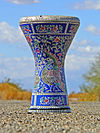Arghul
The arghul (Arabic: أرغول or يرغول), also spelled argul, arghoul, arghool, argol, or yarghul (Israel), is a traditional Egyptian and Palestinian musical instrument. It has been used since Ancient Egyptian times and is still used as a traditional instrument in Egypt and Palestine.
Contents
Basic Characteristics
![]()
(From Edward William Lane's An Account of the Manners and Customs of the Modern Egyptians.)
Modern Arghul, 3 ft. 2½ in. long.[1]
The arghul is a double-pipe, single-reed woodwind instrument that consists of two tubes: a melody pipe with between five and seven holes and a longer drone (Arabic ardiyya, "ground") pipe. Its tone is similar to that of a clarinet, although a bit more reed like. Unlike the similar mijwiz, the arghul only has fingering holes on one of the instrument's pipes (the melody pipe), and the drone pipe has a detachable length that allows the player to alter the pitch of the drone.
In the illustration above all three lengths are shown in use. An arghoul belonging to the collection of the Conservatoire Royal at Brussels, described by Victor Mahillon in his catalogue[2] (No. 113), gives the following scale: —
| Short Pipe. | Drone Pipe. | ||||
 |
 |
||||
| Holes uncovered. |
|
Arghuls are in Egypt and other Arab nations as an accompaniment to belly dancing and other types of Arabic musical performances. Circular breathing is an important part of the playing of the instrument.
There are three varieties of arghuls: The small arghul (arghoul alasghar), the medium arghul (arghoul alsoghayr), and the large arghul (arghoul alkebir).
Çifte
Çifte is a Turkish folk instrument of the wind type. It is made by tying two reed pipes side by side. Two small reed pieces which produce the sound are added to the ends of both reeds. These two small reeds are taken into the mouth cavity and it is played by blowing the air into both at the same time.
There are two çifte types known as Demli Çifte and Demsiz Çifte. In demli çifte one of the reeds does not have any pitch keys and it just produces a background sound. There are melody keys on the other reed and the main melody is played through them
Çifte is also known as Argun, Argul, Kargın or Zambır at different regions.
In Turkish, the word "çifte" also refers to a double-barreled shotgun, no doubt because of the barrels' resemblance to the wind instrument.
Dozaleh
The dozaleh [dozAle] is one of the old folk wind instruments of Iran which is used in mirth celebrations. Abu Nasr Farabi had called it Mezmarol-Mosana or Mozdavadg [mozdavej] ("married"). The dozaleh has a sound like Neyanban [neianbAn] (bagpipe), but to some extent more clear and lower. It is played in Khorasan [xorAsAn], Kermanshah [KermAnSAh], and mostly in Iran. In some different dialects it is called Zanbooreh [zanbureh].
See also
Notes
- ↑ Chisholm 1911
- ↑ Chisholm 1911 cites: Catalogue descriptif et analytique du musée du Conservatoire Royal de Bruxelles (Ghent, 1880), p. 141.
References
- Attribution
 This article incorporates text from a publication now in the public domain: Lua error in package.lua at line 80: module 'strict' not found.
This article incorporates text from a publication now in the public domain: Lua error in package.lua at line 80: module 'strict' not found.
External links
- Arghul page from Zaman Production site
- The making of the Arghul, in Egypt by Dominik Huber
Listening
- Articles containing Arabic-language text
- Wikipedia articles incorporating a citation from the 1911 Encyclopaedia Britannica with Wikisource reference
- Woodwind instruments
- North African musical instruments
- Arabic musical instruments
- Turkish musical instruments
- Syrian musical instruments
- Ancient Egyptian musical instruments




